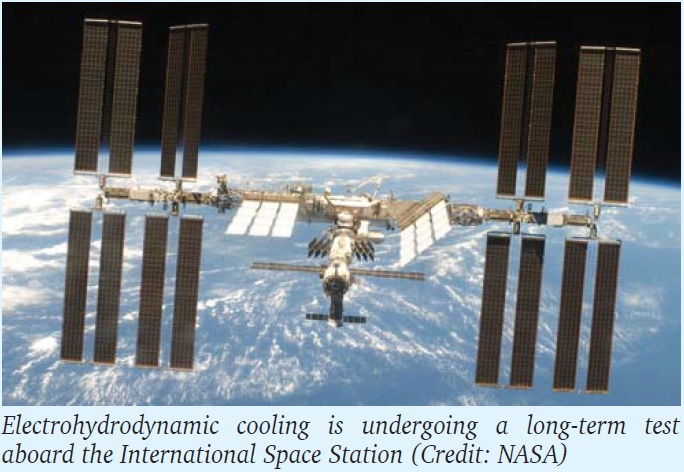When astronauts head for Mars, keeping them cool will be a major concern, so a team of mechanical engineers at the Worcester Polytechnic Institute (WPI) led by Jamal Yagoobi is working on a new electrical cooling system that has no moving parts. Already being tested aboard the International Space Station (ISS), the electrohydrodynamic (EHD) cooler uses electrically charged fluids running through tiny tubes to carry away heat without noise or vibrations. Though a spacecraft set in shadow is theoretically subjected to temperatures hundreds of degrees below zero, the real problem is high temperatures. When subjected to sunlight, the craft will quickly heat up to above the boiling point of water unless its surface is made reflective.But the bigger problem is that space is a vacuum anda spacecraft is essentially a giant thermos flask. Spacecraft
produce a lot of heat from their power systems, electronics, mechanical parts and even the bodies of the astronauts. And because these are all surrounded by a vacuum, the fact that there is no air to conduct or convect the heat away makes getting rid of this heat difficult. Instead, the heat needs to be transferred to panels that allow it to be radiated out into space.
Current systems are not as effi cient as they could be, and their pumps and motors generate noise and vibrations that create their own problems. So a simpler, quieter system that uses less energy has more than one advantage. Called ‘Electrohydrodynamically Driven Liquid Flow in Parallel Micro-Tubes,’ the WPI experiment is being carried out on ISS, where it will operate until this August. It will be replaced in 2021 by a more complex version. Like the present experiment, the more complex Electohydrodynamically Driven Liquid Film Flow Boiling system uses electrically charged liquids for cooling, but instead of using electric fields to just circulate the fluid, the new version uses a twophase, non-mechanical EHD pumping system with a condenser section and a boiling section. This allows the circulating fluid to boil, so it absorbs more heat like in a domestic refrigerator, then it returns to a liquid form as it passes through a radiator, which dumps the heat into a radiator panel and then out into space. The team also sees the technology as having applications on satellites and deep space probes, as well as in industrial cooling and heating, ventilation, air conditioning, and refrigeration
systems back on Earth.
(Source: https://newatlas.com/electrohydrodynamic-coolingspace/54308/)
Disclaimer: The information provided within this publication / eBook/ content is for general informational purposes only. While we try to keep the information up-to-date and correct, there are no representations or warranties, express or implied, about the completeness, accuracy, reliability, suitability or availability with respect to the information, products, services, or related graphics contained in this publication / eBook/ content for any purpose. Any use of this information is at your own risk.
 Youth
Youth
 Women
Women
 Research for Ishrae
Research for Ishrae







